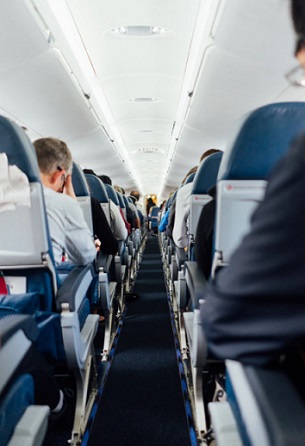 The last thing you want in the confined space of a plane cruising at 35,000ft is a fire caused by a lithium ion battery
The last thing you want in the confined space of a plane cruising at 35,000ft is a fire caused by a lithium ion battery
 An AvSax lithium battery fire containment bag sometimes known as a 'burn bag'
An AvSax lithium battery fire containment bag sometimes known as a 'burn bag'
 Mobile phones can catch fire if they are crushed in aircraft seats
Mobile phones can catch fire if they are crushed in aircraft seats
There have been more than 25 incidents of lithium batteries overheating or catching fire on planes this summer – well over double the amount recorded in the same three months last year.
The report by the Federal Aviation Administration (FAA) in the USA reveals that 26 incidents involving batteries in everyday devices such as mobile phones, laptops, earphones and vapes have been reported to them between the beginning of May and the end of August 2021.
Only 10 incidents were reported in the same four months of 2020 and 15 in the pre Covid-19 pandemic year of 2019.
This means there have now been at least 340 aviation-related incidents involving lithium batteries carried as cargo or baggage recorded since January 23, 2006.
Several of the recent incidents were contained in special battery fire containment bags which many airlines now carry on board. A fire sparked by a lithium battery in the confined space of a passenger jet cruising at 35,000 can be potentially catastrophic.
Passengers take hundreds of personal electronic devices (PED) on board every flight which means there is always the possibility one of them could catch fire if the lithium batteries in them overheat. This could be sparked by several reasons from the device falling down the aircraft seats and then being crushed to batteries that are a cheap copy and manufactured to a poor standard.
When lithium batteries overheat or catch fire they go into what’s known as thermal runaway.
This happens when one cell in a battery overheats it can produce enough heat – up to 900°C (1652°F) – to cause adjacent cells to overheat. This can cause a lithium battery fire to flare repeatedly and they are very difficult to put out which is why many airlines carry award-winning AvSax battery fire containment bags designed to deal with overheating or burning PEDs.
AvSax managing director Richard Bailey said: “The fact the number of lithium battery fires has more than doubled over the last year is certainly very worrying for all airlines and shows there is a real problem with lithium batteries catching fire on aircraft.
“These figures are only collated by the Federal Aviation Administration in the USA which indicates there may be an even greater problem worldwide.”
Recent incidents include a flight on an Alaska Airlines plane when a passenger’s e-cigarette started overheating. The device was put in a battery containment bag. On another Alaska Airlines flight a passenger was sleeping with a flashlight around their neck when the battery began to burn. The flashlight was put in a ‘burn bag’ and no-one was hurt.
On a United Airlines flight a passenger’s e-cigarette began smoking while in flight. Airline personnel used a thermal containment bag to contain the incident. On another United Airlines flight a battery charger overheated and released a small amount of smoke inside the aircraft. The charging device was placed inside a thermal containment bag.
On an Envoy Air flight a lithium battery powered vape pen went into thermal runaway and started sparking. A flight attendant sprayed the vape device with a halon extinguisher and placed it into a battery fire containment bag until the plane landed.
A passenger’s power bank started smoking while an American Airlines flight was on the runway just before take-off. The power bank was placed inside a lithium battery fire containment bag and the aircraft returned to the gate.
On a Horizon Air flight a passenger’s pair of ear buds started smoking and were placed in a containment bag by the cabin crew. The plane was taxiing for take-off so returned to the gate.
An iPad went into thermal runaway during a United Airlines flight from Korea to San Francisco International Airport over the Pacific Ocean and the incident was quickly contained by airline personnel.
On a Southwest Airlines flight a piece of luggage containing a lithium battery powered multi-charger device was found smoking while being transferred to another flight. On another Southwest Airlines plane a passenger was charging a laptop computer with a small power bank when the power bank started to smoke and went into thermal runaway but the incident was contained by the cabin crew.
AvSax are the world’s best-selling fire containment bag for PEDs on aircraft and are now on more than 15,373 aircraft operated by 80 airline companies. They have been used 33 times to deal with emergencies since the start of 2017 and every time they have been deployed the aircraft has been able to complete its journey safely with no need to divert or make an emergency landing. Diversions can be very costly to the airline company and can even run into hundreds of thousands of dollars.
AvSax won the prestigious Queen’s Award for Enterprise in the UK in 2018.